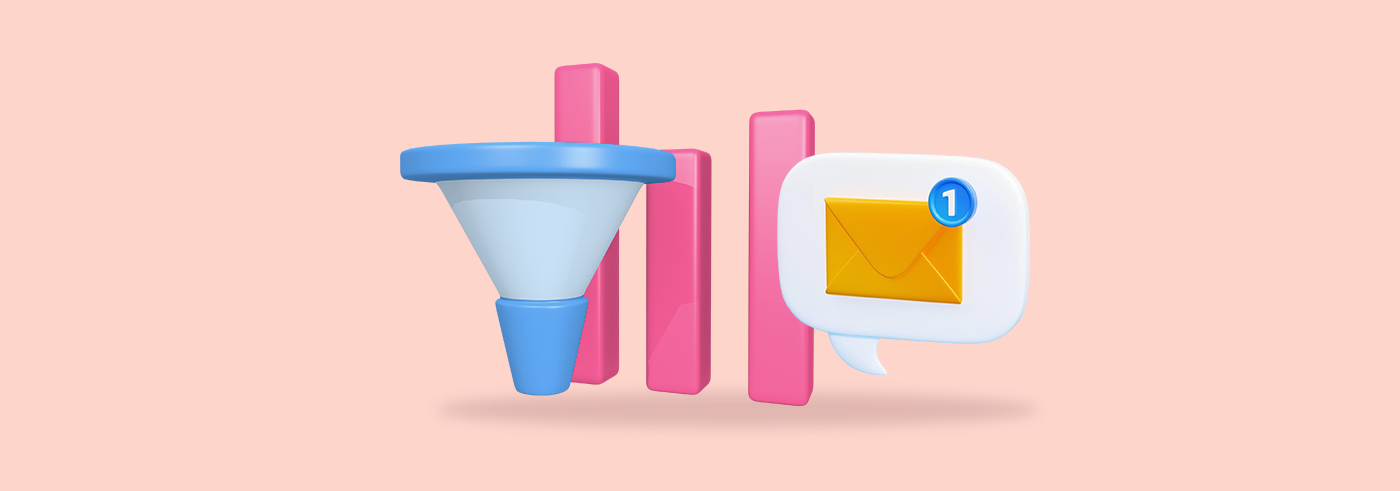During your marketing journey it's likely you've come across many different marketing concepts, ideas, and examples. Today we'll be going over the idea of the marketing funnel and how it can help you increase your email marketing ROI.
Table of Contents
- What is the email marketing funnel?
- 6 email marketing funnel stages you need to know
- Why are email marketing funnels useful?
What is the email marketing funnel?
The marketing funnel is a concept and image designed to help visualize how a lead can be turned into a customer. This idea is based on a marketing and sales viewpoint but can be applied to enhance a variety of business or organizational strategies. In fact, the funnel concept can be applied to many portions of your website, email campaign strategy and more to evaluate how a specific series of steps or flow is working or not working. It's important to understand that there is no single marketing funnel. Some include many different stages while other versions include just a few basic steps.
Basically, the idea is to categorize the actions that a potential customer may take before they become a confirmed customer or client. In other words, a funnel can be used to track everything a person is likely to do before they make a purchase or otherwise to commit to your product, group or service. It's shaped like a funnel because there is a wider audience at the beginning of this process, then as people go through the stages there tends to be fewer and fewer. It's important to note however that it would be ideal if the funnel was more of a cylinder shape instead, meaning all individuals who are aware of your product, show interest then become customers. That would be the ultimate goal perhaps, but for now, let's get into more detail about the stages.
6 email marketing funnel stages you need to know
Awareness
This is your most basic and beginning stage of the funnel email marketing. It includes your advertising and other marketing campaigns. It may be your invitation to sign up for your email newsletter or blog. Leads from social media, trade shows, webinars and more are gathered, so these new contacts can be nurtured. Help spread awareness about your product or service by integrating a web form.
Interest
This stage is for learning more about the company, group, product or service that you offer. This is an opportunity to communicate with your leads via your email campaigns and share your brand message. Companies can use valuable content to improve and build relationships with new contacts that have shown interest in your solution. Get creative with your welcome emails by using some email marketing funnel template.
Evaluation
During this part of the marketing funnel, leads have matured into potential customers. Now, companies can continue to nurture these relationships by providing more information, free trials, support and more. This is a great time for automated email campaigns that keep providing value while the potential customer considers making a purchase. Get your automated campaigns going to higher email engagement.
Commitment
Here a potential customer is demonstrating a strong intent to purchase. They may have clicked several links on your emails that lead to information about sales or products. They may have responded to a survey you've emailed out and expressed their confidence and interest in your product. This is an important time to remind this customer why your product or service is the best choice. Use all of your Contact Delivery and Optimization Tools to make the most powerful impression on your contacts.
Purchase
Yes! Your potential customer is now an established customer since they have made a purchase (or joined your group or used your service, this email marketing sales funnel is focused on purchasing, but it can be applied to other types of recruitment or services). Here a good experience is essential to help encourage future purchases and takes steps towards the final stage. Follow up by reviewing the process that led to a purchase and make sure you continue to provide your contact with great emails.
Advocacy
This is an important part of the funnel because it helps keep the cycle going. Good experiences with your brand can fuel positive reviews and direct referrals that help you grow your business. A great review is a great referral!
Why are email marketing funnels useful?
The concept of a email marketing funnel is to basically show where customers can be lost. With a funnel analysis, it's possible to learn where the weak spots are in whatever process you're trying to analyze. Then, you can focus your improvement efforts on where they are needed most. Creating a funnel to review how your email subscribers are signing up, whether or not your emails are getting opens and clicks depending on the campaign you send, or if you're trying to improve your email marketing ROI by increasing direct through email sales are all examples of workflows you can track.
Using a funnel concept to measure and observe whatever customer journey you want to evaluate can be a useful source of information to help you narrow your focus and achieve results.







